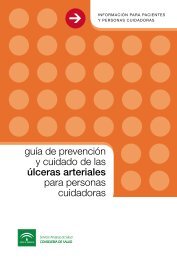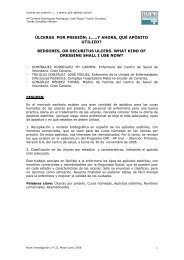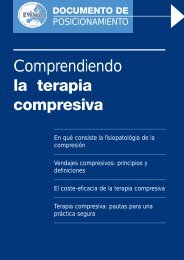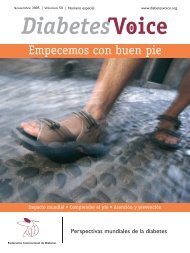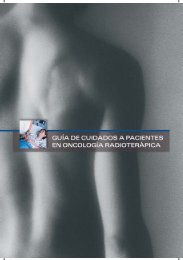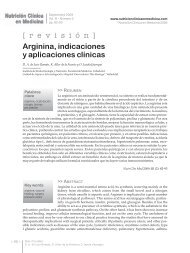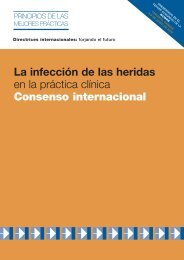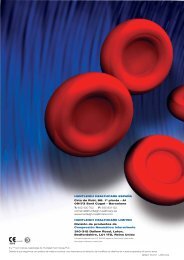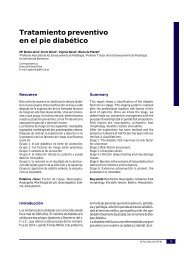Descargar - Úlceras.net
Descargar - Úlceras.net
Descargar - Úlceras.net
- No tags were found...
You also want an ePaper? Increase the reach of your titles
YUMPU automatically turns print PDFs into web optimized ePapers that Google loves.
24 ■ PIE DIABÉTICOAngiographyConventional contrast intra-arterial subtractionangiography is the most commonlyused imaging modality for planning a vascularintervention. It allows a detailed analysis ofthe complete arterial tree with characterizationof the arterial obstructions encountered.It is not influenced by arterial calcification andthus overcoming a limitation Duplex Scan andpermits a detailed visualization of the tibioperonealand foot circulation. Howeverangiography is associated with several complications,including access site complications,serious reaction to the contrast medium, contrast-inducedrenal function impairment and a0.16% risk of mortality.Mag<strong>net</strong>ic Resonance AngiographyGadolinium-enhanced Mag<strong>net</strong>ic Resonanceangiography (MRA) is being increasinglyused because it can provide detailed imagingof the arterial tree without the need of an arterialpuncture or the use of standard contrastagents. Several studies have shown thatMRA can be non inferior to angiography in theidentification of suitable arteries for revascularization,including pedal arteries, and is notinfluenced by the presence of calcification. Itseems, however, to overestimate the degreeand the extension of stenosis.Although gadolinium is mildly nephrotoxicit can adversely affect renal function in patientswith prior renal impairment. Recentlythere have been several reports of nephrogenicinduced systemic fibrosis related togadolinium administration to patients with severelycompromised renal function.Computed Tomographic AngiographyWith development of the recent multi-slicedetectors CT angiography is being increasinglyused to evaluate peripheral occlusive disease. Itallows a quick acquisition of images, minimizingissues related to patient noncompliance, anddelivers three-dimensional reconstruction ofthe arterial tree. Wall calcification frequently impairsthe determination of artery patency onreconstructions, requiring careful evaluation ofindividual axial slices and limiting its ability tostudy distal arteries of the limb.CTA also involves the administration ofhigh volume of iodine contrast that can inducerenal deterioration, thus limiting further itsapplication in diabetic patients.Imaging strategy for revascularizationIn patients with impaired renal function, asdiabetic patients often are, the risks of contrastinduced renal failure and of nephrogenic systemicfibrosis are not negligible and pose achallenge for the vascular specialist. Althoughconventional angiography still remains themodality of choice for planning of vascular intervention,duplex imaging can provide enoughinformation to plan a revascularization procedure,specially if the pattern of disease seems tobe adequate for endovascular intervention. Inthese cases, angiographic confirmation of thelesions observed can be accomplished duringthe endovascular intervention.Nevertheless, in our experience, angiographystill has a major role when pattern diseaseevaluated clinically and by duplex suggests theneed for surgical revascularization. MRA hasbeen increasingly used as a mapping imagingmodality in numerous centers and may gain amore prominent role in the future.TREATMENTAll diabetic patients with PAD should receiveoptimal risk factor management, adequateglycemic control and aggressive treatmentof foot infections (3,8). The most difficultquestion to answer on these patients managementis whether revascularization is warranted,for a certain lesion, in a certain patient.Some patients with minor distal gangrene orsmall ulcer and moderate occlusive disease canbe treated with small amputations, antibioticsand wound care measures, whereas patientswith severely ischemic limbs and extensivelesions will require a vascular intervention.





